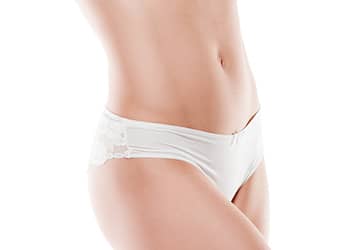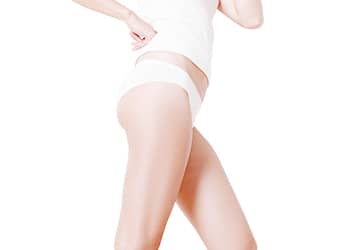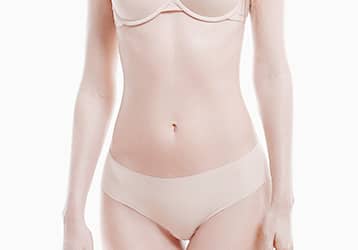Panniculectomy Surgery in Ohio: Overview and Procedure Details

Overview
The risk of health problems associated with obesity and the many changes that pregnancy entails on the body, including weight gain, have encouraged women and men alike to shed the extra pounds and commit to a healthy lifestyle.
But while losing weight has positive effects on one’s health, it leaves a large, apron-like portion of excess skin and fat deposits in the abdomen, a common aesthetic and medical problem following massive weight loss. It not only restricts normal activities but affects one’s daily life as well.
To address this problem, many patients opt to undergo a surgical procedure known as panniculectomy. Panniculectomy is a type of abdominoplasty designed to remove the excess skin and fat deposit in the abdomen after significant weight loss.
What is Panniculus?
Medically known as the panniculus, this layer of extra fat and excess skin in the abdomen may resemble an apron. Its formation is caused by layers of extra fat and overstretched skin following either massive weight loss or pregnancy.
There are five grades of panniculus based on its level of severity:
- Grade I: The panniculus covers the pubic hairline
- Grade II: It completely covers the genitals up to the thigh crease
- Grade III: It extends down to the upper thighs
- Grade IV: The panniculus reaches the mid-thighs
- Grade V: It covers the knees and may even reach lower
Cost, Insurance and Financing
The total cost of your panniculectomy depends on several factors, which should be discussed during your preliminary consultation. These factors include:
- Diagnostic tests needed before surgery
- Your overall health and medical conditions
- Hospital, aesthetic center, or clinic facility fees
- Choice of anesthesia or sedation
- Surgical techniques required to remove the excess skin, fat, and tissues
- Other surgical procedures combined with panniculectomy, if any
- Post-operative medications and supplies
- Post-operative follow-up visits
- Qualifications and experience of the plastic surgeon
Insurance Coverage
In general, insurance companies usually cover the expenses for a panniculectomy, when the reasons for undergoing the procedure are justified medically (i.e. causes health problems and hinders daily living and normal activities). When a panniculectomy is performed for aesthetic reasons, your insurance company is unlikely to cover for the expenses. It is advised that you check with your insurance agent to discuss the costs and possible payment plans they may offer.
Financing
Even if your insurance company denies coverage for your panniculectomy procedure, you may qualify for special financing plans to help you cover for the cost of the procedure. Inquire with our staff during your consultation visit.
Benefits of Panniculectomy
Most patients choose to undergo panniculectomy because they want to get rid of the excess, apron-like skin below their waistline and lower abdomen.
A panniculectomy yields a flatter midsection, providing an enhanced body contour that can significantly boost your confidence and self-esteem. Aside from addressing aesthetic problems in the abdominal area, panniculectomy helps alleviate the following conditions:
- Back pain
- Discomfort from having loose skin hanging in front of the abdomen
- Skin irritation in the pubic region such as swelling, chafing, rashes, and skin ulcers that can lead to infections
- Hygiene problems
- Mobility issues
- Problems with sexual activities
Before the Surgery
During the initial consultation, you will have the opportunity to discuss and plan your surgery. First, we will help you determine whether a panniculectomy is right for you, while discussing your medical history and performing a physical examination.
You must be willing to provide your complete medical history and answer questions about the current status of your health. You should also inform us about medications you are taking on a regular basis. Likewise, we can discuss your preferences and desired results during this time.
During the consultation, our surgeons will:
- Explain and describe the panniculectomy procedure in detail
- Discuss your treatment options, including the surgical techniques appropriate for you and the outcomes you can expect
- Provide before and after photos to further specify your preferences
- Describe and explain the possible risks and complications associated with a panniculectomy procedure as well as suggest ways to minimize these possibilities
- Discuss the necessary preparations and post-operative instructions for a panniculectomy
- Discuss payment options and financing plans that are available
- Address any further questions and/or concerns about the procedure
Preparing for a Panniculectomy
Specific instructions on how you can prepare for the surgery is provided during your consultation. In most cases, we advise patients to stop smoking and drinking at least a month prior to surgery to decrease the risk of complications upon recovery.
In addition, we recommend avoiding medications such as aspirin, ibuprofen, and health supplements at least two weeks before surgery. These may promote bleeding that can affect your healing.
Our plastic surgeons also advise against shaving the area, especially near the groin and genitals, two days before your surgery. You will be asked to shower the night before and on the morning of surgery with an anti-bacterial soap that will be provided.
You will also need to undergo laboratory tests, including electrocardiogram and chest X-ray to further affirm your suitability for surgery.
With regards to eating and drinking, it may depend on your choice of anesthesia. If you opt for:
- Local anesthesia: You may still eat and drink on the day of the surgery
- Intravenous sedation and General anesthesia: You may not eat or drink anything after midnight of the night before surgery. However, you may drink clear liquids up to three hours before the operation.
During the Surgery
On average, a panniculectomy takes three to five hours to complete. There are different levels of complexity involved with this surgical procedure, depending on the location and amount of skin and soft tissue that needs to be removed.
We customarily use general anesthesia for a panniculectomy, but in certain circumstances, the option of using local anesthesia and/or intravenous sedation is considered.
Panniculectomy Techniques
Standard panniculectomy: A low transverse incision from hip-to-hip along the pubic region in the shape of an oval is created to remove the excess skin and soft tissue. The remaining skin is drawn together and sutured closed.
Fleur-de-lis Panniculectomy: In addition to a standard panniculectomy incision, a vertical midline incision is made from the sternum (or breast bone) to the pubic bone to remove excess skin from the upper portion of the abdomen. Again, the remaining skin is drawn together and sutured closed.
Request Your Consultation
To learn more about panniculectomy, you can schedule an appointment online or you can call 855-687-6227
Recovery
Panniculectomy, in itself, is an invasive and extensive surgical procedure. If combined with other body contouring procedures, it can become quite rigorous. The operation requires a minimum of an overnight stay, but possibly up to one week at the hospital depending on the extent of the operation and the status of your overall health.
Recovery from any surgery varies from patient to patient. Your recovery from a panniculectomy depends on the extent of the operation. In general, you will be able to walk immediately following surgery.
Right after your surgery, the wounds will be dressed. In addition, surgical drains will be inserted in the treated areas to collect excess fluid and blood from under the wound. To preserve the safety of these wounds, you can only resume showers after two days. The drains will be removed after two weeks, and after four weeks, you may resume taking full baths.
Your stitches will be removed after one week, and within three weeks, you can return to work. It will take between 6-8 weeks for your body to completely recover from surgery.
During healing you may:
- Change your dressings every day as instructed. Additionally, you must wear a compression garment at all times for the first month. This will help your body settle into its new contour.
- Avoid applying lotions, solutions, or herbal preparations on your incisions except when directed by our plastic surgeons.
- Avoid putting pressure on your wounds.
- Postpone any strenuous activities, including exercise and lifting, for six weeks. We encourage you to consult with us before performing additional activities while recovering.
- Have someone drive for you for two or three weeks after surgery. You may wear your seatbelt during the drive given that you place a small pillow over your abdomen to prevent direct application of pressure on your incisions.
Risks and Complications
While surgery is safe when performed by our plastic surgeons, like any surgery, a panniculectomy will have risks and potential complications. These include:
- Adverse reactions to anesthesia and/or sedation medications
- Infection
- Bleeding
- Excessive scarring
- Delayed wound healing
- Fluid and blood accumulation that may require surgical evacuation
In addition, if you notice the following conditions, we advise you to go to the nearest hospital for immediate care:
- Body temperature higher than 100.5 °F (38 °C)
- Excessive bleeding or drainage of fluid
- Presence of thick, yellow/tan purulent or foul-smelling drainage
- Unusual redness around the incision sites
- Increasing pain that cannot be relieved by pain medications
- Nausea and vomiting
If you experience any of the concerns mentioned above, contact our office immediately.
Results
After your panniculectomy, results can be seen immediately. Your midsection and lower abdomen will look flatter and smoother without the hanging apron of skin and tissue. If you combined it with other procedures such as abdominoplasty and/or liposuction, your contour will be more pronounced with a streamlined and proportional figure.
In general, we advise our patients to maintain a steady weight and a healthy lifestyle to preserve the outcome of their panniculectomy. Keep in mind that the outcome of any plastic and/or cosmetic surgery is only as good as your willingness and ability to maintain it.
The resulting scars from your panniculectomy will improve with time. Follow the post-operative instructions to allow optimum healing. Scars can improve for up to 12 months after surgery with proper care.
Are You a Good Candidate for a Panniculectomy?
You are suitable for a panniculectomy if you:
- Have experienced massive weight loss
- Have undergone bariatric surgery to treat obesity
- Have given birth and want to lose the excess skin below the belly button and extra weight gained
- Have excess, apron-like, loose skin suspended in front of your abdomen, which causes:
- skin irritations in the pubic area
- back pain
- hygiene problems
- mobility issues
- Do not plan to become pregnant in the near future
- Actively maintain a stable weight
- Are physically and mentally healthy
- Are not a heavy drinker or smoker
- Are committed to a healthy lifestyle
If you have undergone a bariatric surgery procedure, you must wait at least a year before undergoing a panniculectomy. This will ensure that your weight has stabilized and that any health problems resulting from obesity (e.g. diabetes, high blood pressure, heart conditions) are improved or under control.
How to Choose a Panniculectomy Surgeon in Ohio?
In choosing a plastic surgeon, it is important to consider his/her qualifications, training, and experience in performing the procedure. The cost of the surgery is only a secondary consideration. More specifically, you should choose a plastic surgeon who:
- Is certified by the American Board of Plastic Surgeons and other accrediting associations
- Frequently performs panniculectomy and other body contouring procedures
- Considers your preferences and goals
- Has operating privileges in an accredited hospital in case of emergency
- Has facilities that are accredited, state-licensed, and conducive for performing the procedure
- Has before and after photos that you can reference
- Has a high success rate in performing a panniculectomy
Frequently Asked Questions
1. Can I combine Panniculectomy with other body contouring procedures?
Yes. A panniculectomy can be a stand-alone procedure, however if you are looking for a more dramatic and aesthetically pleasing outcome, you can combine it with other procedures, including:
- Traditional Tummy Tuck (Abdominoplasty)
- Liposuction
- Mommy Makeover procedures
During the initial consultation, we encourage patients to discuss their desired outcome and preferences. This way, we will be able to recommend the appropriate combination of procedures that would yield the best possible outcome from the surgery.
2. How is Panniculectomy different from a Tummy Tuck (Abdominoplasty)?
While both procedures address problems concerning the abdominal area, a panniculectomy procedure and a traditional tummy tuck procedure have major differences:
Panniculectomy is a procedure designed to specifically remove the panniculus from the front of the lower abdomen. A traditional tummy tuck targets the excess and loose skin in the abdomen and addresses the separation of abdominal muscles.
*The information available on this page was created to educate our patients. It is not an alternative for a formal consultation with a board-certified plastic and reconstructive surgeon. Individual results vary per patient. For more information, we strongly recommend scheduling a consultation with our doctors.



